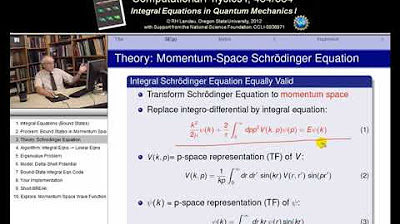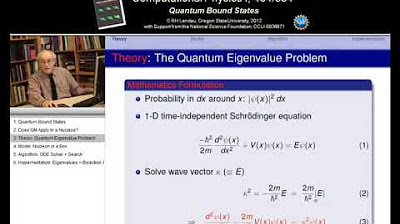26.3 Integral Equations for Quantum Scattering
TLDRIn this final lecture, the speaker delves into the advanced topic of quantum mechanics, specifically addressing scattering in momentum space. They discuss the complexities of solving the Schrödinger equation with non-local potentials and the transition to momentum space for scattering problems. The lecture introduces the Lippmann-Schwinger equation for calculating scattering amplitudes and cross-sections, and the challenges of handling singular integrals are tackled with analytical and computational techniques. The speaker guides through the process of converting integral equations into matrix form for numerical solutions, using the delta shell potential as an example. The lecture concludes with an encouragement to practice these computational methods and compare numerical results with analytical expectations.
Takeaways
- 🎓 The lecture is the final one, covering advanced graduate or possibly research-level material, focusing on quantum mechanics and scattering in momentum space.
- 🧩 The lecture combines various complex concepts, including interesting mathematics and computing, to explore the subject matter in depth.
- 🔬 The speaker has personal experience in the field, having conducted research for decades and even contributed to some of the programming for the topic discussed.
- 📚 The lecture assumes familiarity with the bound state problem in momentum space, urging those unfamiliar to review previous material before proceeding.
- 🚀 The problem setup involves a projectile within a multi-particle medium, where the potential felt by the projectile is non-local, leading to a complex Schrödinger equation.
- 🌌 The lecture discusses solving the Schrödinger equation in momentum space, which is integral to understanding scattering problems in quantum mechanics.
- 🔍 The concept of a center of momentum system is introduced, which is crucial for understanding the kinematics of scattering in the context of the lecture.
- ⚛️ The Lippmann-Schwinger equation is highlighted as a key tool for solving scattering problems, offering a way to calculate the scattering amplitude directly.
- 📉 The lecture addresses the challenge of handling singular integrals in computing, explaining the use of analytic skills alongside computational methods.
- 📝 The process of converting the integral equation into a matrix equation is outlined, a method that simplifies the solution of complex problems in quantum mechanics.
- 🔧 The use of numerical methods to solve for the scattering amplitude is discussed, including the application of Gaussian quadrature and matrix inversion techniques.
Q & A
What is the main topic of the last lecture in the book?
-The main topic of the last lecture is quantum mechanics and scattering in momentum space, which involves advanced and research-level concepts.
Why is the lecturer discussing the area of quantum mechanics and scattering in momentum space?
-The lecturer has done research in this area for several decades, and they have contributed to writing some of the programs used in this field, making it a topic they are passionate about.
What is the significance of solving the Schrödinger equation in momentum space instead of coordinate space for scattering problems?
-Solving the Schrödinger equation in momentum space for scattering problems allows for the use of the center of momentum system, which is more appropriate for describing the kinematics of scattering.
What is the Lippmann-Schwinger equation and why is it used?
-The Lippmann-Schwinger equation is an integral form of the Schrödinger equation used to solve for the scattering amplitude, which is directly related to the experimental observable, the scattering cross-section.
Why is the Schrödinger equation in coordinate space difficult to solve?
-The Schrödinger equation in coordinate space is an integral differential equation, which is hard to solve due to the need for iterative solutions and approximations for both derivatives and integration.
What is the Cauchy principal value integration and how is it used in the context of singular integrals?
-The Cauchy principal value integration is a method for dealing with singular integrals where the integrand has a singularity at a certain point. It involves integrating just to the left and right of the singularity without passing through it, effectively avoiding the singularity.
How can the singularity in the integral equation be handled numerically?
-The singularity can be handled numerically by using analytic skills combined with computational skills, such as giving the energy a small imaginary part or using the Cauchy principal value prescription to avoid the singularity during integration.
What is the purpose of converting the integral equation into a matrix equation?
-Converting the integral equation into a matrix equation allows for the use of matrix algebra to solve the equation more efficiently and to handle the unknowns in a systematic way.
Why is the inverse of the matrix used in the solution of the scattering problem always guaranteed to exist?
-The inverse of the matrix exists for scattering problems because any energy is a solution to the Schrödinger equation in the continuous spectrum for scattering, unlike bound states where the inverse may not exist due to the eigenvalue problem.
How can the accuracy of the numerical solution for the scattering problem be improved?
-The accuracy of the numerical solution can be improved by varying the number of grid points used in the computation, increasing precision until roundoff error becomes a limiting factor.
What is the relationship between the computed sine squared of the phase shift and the experimental observable?
-The sine squared of the phase shift is proportional to the cross section that the experimentalist would measure, providing a direct comparison between theory and experiment.
Outlines
🎓 Final Lecture on Advanced Quantum Mechanics
The speaker begins the final lecture of the book, indicating that the content is of a graduate or research level, involving complex mathematics and computing. The lecture focuses on quantum mechanics and scattering in momentum space, an area the speaker has researched for decades. The bound state problem in momentum space is reviewed as a prerequisite, and the non-local potential in a multi-particle medium is discussed. The speaker introduces the Schrödinger equation in this context and explains the transition to solving problems in momentum space, including the concept of a center of momentum system. The lecture aims to open doors to further opportunities in the field.
🔍 Exploring the Lippmann-Schwinger Equation for Scattering
The speaker delves into the Lippmann-Schwinger equation, an integral form of the Schrödinger equation used for scattering problems. The equation is explained as a means to find the scattering amplitude, which is related to the experimental observable, the scattering cross-section. The challenges of solving the integral equation are discussed, including the singularity issue and the use of the Cauchy principal value integration to handle it. The speaker also explains the concept of a singular integral and its relevance to the problem at hand, emphasizing the need for both analytic and computational skills to address these challenges.
📚 Numerical Methods for Singular Integrals in Quantum Mechanics
The speaker discusses methods for computing singular integrals, which are crucial for solving the scattering problem in quantum mechanics. Three different approaches are presented: giving the energy a small imaginary part to avoid the singularity, using the Cauchy principal value prescription, and employing Hilbert transforms. The speaker illustrates these methods with mathematical functions and explains how they can be applied to the Lippmann-Schwinger equation. The importance of careful numerical work when dealing with singularities is highlighted, and the speaker provides insights into how to handle these in computations.
🧩 Converting Integral Equations to Matrix Form for Computation
The speaker outlines the process of converting the integral equation, specifically the Lippmann-Schwinger equation, into a matrix equation to facilitate numerical computation. The method involves rewriting the equation with a subtraction term to eliminate the singularity and then approximating the integration using Gaussian quadrature points. The resulting set of algebraic equations is then expressed in matrix form, allowing for the use of matrix libraries to solve for the unknowns. The speaker emphasizes the clever manipulation of the equation to ensure it can be computed numerically.
🔄 Solving the Matrix Equation for Scattering Amplitudes
The speaker describes the process of solving the matrix equation obtained from the Lippmann-Schwinger equation. The equation is manipulated to isolate the unknown vector, which represents the scattering amplitudes. The solution involves matrix inversion, which is possible due to the nature of scattering problems having a continuous spectrum. The speaker provides a Python code snippet that demonstrates how to perform the matrix inversion and solve for the scattering amplitudes, which are related to the cross-section measured in experiments.
📉 Analyzing the Results and Comparing with Analytic Solutions
The speaker presents an analysis of the numerical results obtained from solving the scattering problem using the matrix inversion method. The results are compared with the analytic solution for the delta shell potential, a specific case in quantum mechanics. The speaker notes the challenges in obtaining precise numerical results, especially near resonance peaks, and suggests increasing the number of grid points for improved accuracy. The importance of validating numerical solutions with analytic checks is emphasized.
👋 Concluding the Lecture Series with a Look Forward
In the final paragraph, the speaker concludes the lecture series by encouraging students to undertake the computation for the delta shell potential in momentum space. The speaker provides guidance on how to approach the problem and what to expect in terms of results. There is an acknowledgment of the challenges in numerically integrating the delta shell potential and a reminder to compare the numerical results with the provided analytic solution. The speaker thanks the audience for their participation and expresses hope that they will continue to engage with the material.
Mindmap
Keywords
💡Quantum Mechanics
💡Momentum Space
💡Schrödinger Equation
💡Non-local Potential
💡Center of Momentum Frame
💡Scattering Cross-section
💡Lippmann-Schwinger Equation
💡Singular Integral
💡Cauchy Principal Value
💡Gaussian Quadrature
💡Matrix Equation
Highlights
Introduction to the final lecture on quantum mechanics and scattering in momentum space, an advanced topic combining various mathematical and computing concepts.
Discussion on the bound state problem in momentum space as a prerequisite for understanding the current lecture.
Explanation of non-local potential in multi-particle media and its impact on the Schrödinger equation.
Introduction to the concept of the center of momentum system in scattering problems.
The transition from solving the Schrödinger equation in coordinate space to momentum space for scattering.
Introduction to the Lippmann-Schwinger equation, an integral form of the Schrödinger equation for scattering amplitudes.
The challenge of solving singular integral equations in computing and the need for analytic skills.
Description of the Cauchy principal value integration method for handling singularities.
The use of Hilbert transforms in evaluating principal value integrals.
Conversion of the Lippmann-Schwinger integral equation into a matrix equation for numerical solution.
Technique of adding a zero-value integral to handle singularities in the equation.
The use of Gaussian quadrature points to approximate integration in the equation.
Inversion of the matrix to solve for the scattering amplitudes, a method applicable to scattering problems with continuous spectra.
Python code provided for direct solution of the matrix equation using matrix inversion.
Analysis of numerical results for the delta shell potential and comparison with analytical solutions.
Recommendation to vary the number of grid points to increase precision in numerical computations.
Conclusion and farewell, encouraging readers to engage with the material and apply the concepts learned.
Transcripts
5.0 / 5 (0 votes)
Thanks for rating:





